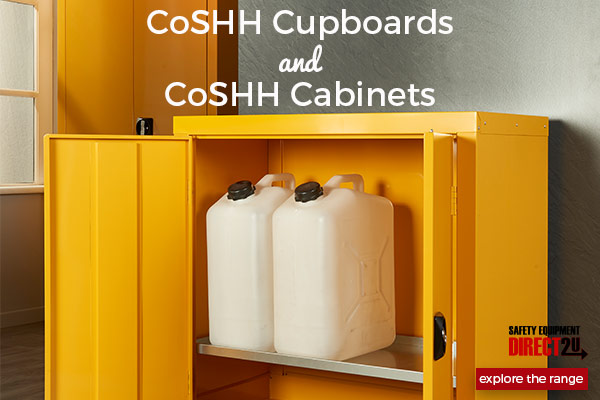In this article, we aim to highlight the main points of consideration when handling and storing substances that can be considered as hazardous to health. With particular reference to CoSHH Cabinets and CoSHH Cupboards as a means of safe storage.
First and foremost, What is CoSHH?
In short, CoSHH is an abbreviation of a technical term, which is Control of Substances Hazardous to Health. CoSHH is a health and safety legislation which is regulated by the government. In particular, CoSHH law binds all employers to take the relevant steps to minimise the risk of harm from chemicals that they store for use by their teams. Undoubtedly a CoSHH assessment is mandatory under CoSHH regulations, and as a result of its importance is often separate to a health and safety assessment. Although they do link in places and should refer to one another.
What are the most common CoSHH precautions?
Although we can implement measures to stop accidents from happening, unfortunately, at times, they are inevitable. For this reason, it is paramount that you devise a clear emergency procedure. You should also educate your teams on the hazards of the products they are working with, as well as the they must follow in the event of an accident.
Although this may seem confusing, do not worry. You can satisfy all these within your CoSHH and Risk assessments. In addition, you can find a library of information and advice from the Health and Safety Executive (HSE). In order to help you get started, the HSE note these 7 steps:
- Identify what all the health hazards are
- Outline how to prevent harm to health
- Implement control measures to reduce risks as well as damage to health
- Ensure use of equipment and procedures
- Regularly review all control measures as well as to check their condition and effectiveness
- Provide regular information, instruction and training to all necessary parties
- Conduct detailed plans for the event of an emergency
What products come under CoSHH?
CoSHH applies to any substance that is classed as a corrosive, irritant, toxic, harmful or poisonous. HSE also help by categorizing these as:
- Chemicals or,
- Products containing chemicals,
- Fumes,
- Dusts,
- Mists,
- Nanotechnology,
- Gases and asphyxiating gases,
- Biological agents,
- Germs that cause disease,
What can we use to store CoSHH substances?
The most effective and compliant way to store harmful substances is in a CoSHH cabinet. Commonly available in different sizes and colours, all specifically made to suit the nature of the chemical you wish to store within them. These include flammable cabinets, agrochemical cabinets, pesticide cabinets and acid and alkali cabinets. As a result of the damage that these substances can cause, CoSHH cabinets tend to feature reinforced lockable doors, liquid tight sumps and multiple shelf levels. These in turn help you keep your chemicals clean, secure and organised. However, we recommend that before you buy a CoSHH cabinet, you consider any single location volume restrictions which each individual chemical may have.
How do you store hazardous substances?
There is no one single way to store hazardous substances. Our advice is that you consult the manufacturers instructions as a starting point, and expand on this within your health ans safety assessments.
Who should have access to a CoSHH cupboard?
Your CoSHH and Risk Assessments should highlight who the responsible person/s are for each of your CoSHH cabinets and its contents. Primarily, access privileges should be given to a strictly limited number of trustworthy and responsible employees. You must ensure the appointed persons are completely aware of their duties in relation to the CoSHH cupboard and its contents. This training should be documented and recorded.
Which CoSHH cupboard or cabinet is best?
There is no definitive answer to this question. It completely depends on the nature of what you are storing and where. Surprisingly, there are a wide range of CoSHH compliant storage products available. These include ones of different sizes, colour and designs. All of which are specific to the type of substance for which they are for. Popular designs include static or mobile floor cupboards or wall cabinets. Most of which are available with additional shelves and floor stands. To enhance access and improve the effectiveness of the cupboard.
